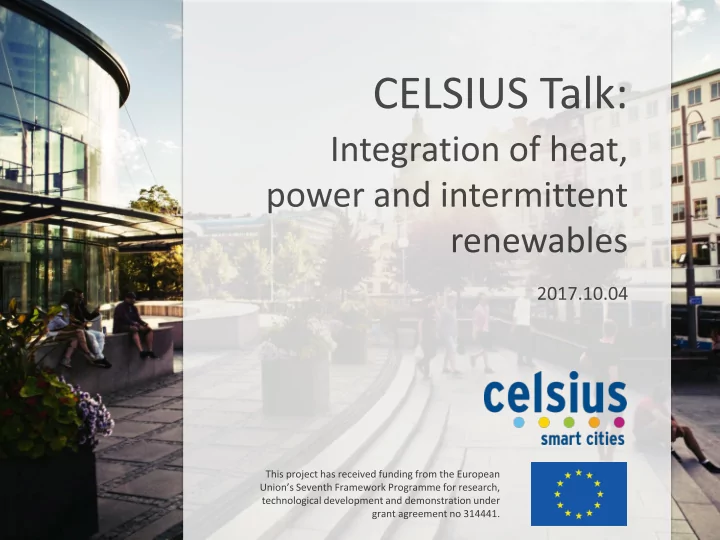

AGFW-Definition of Power-to- (District) Heat How we define „Power -to-(District)Heat (P2H) » – industrial-scale, central transformation of electricity into heat – embedded in a mulitvalent heat generation portfolio, optional usage of different fuels (renewable or fossil) and/or electricity – preferably combined heat and power plants, efficiently transformation in heat and power Electric flow heaters Electrode boilers 50 kW to approx. 15 MW > approx. 10 MW AGFW | Energy efficiency association for heating, cooling and CHP Donnerstag, 20. Dezember 2012
Municipal P2H-applications in Germany Company Electr. capacity Year planned Sum Source: AGFW AGFW | Energy efficiency association for heating, cooling and CHP Donnerstag, 20. Dezember 2012
P2H-application and business models Creation of value by P2H Utilization of nationwide surplus Utilization of local or RES electricity (whole market regional surplus RES range / Europe) Provision of electricity balancing power source: BTB, NEW ENERGY, TU Berlin Time or ratio of fluctuating RES electricity nationwide » Power-to-(District)Heat has different utilization options regarding the German Energy transition (Energiewende) – Provision of balancing power – Utilization of local or regional surplus RES electricity (grid bottlenecks) – Utilization of nationwide surplus RES electricity (whole market range / Europe) AGFW | Energy efficiency association for heating, cooling and CHP Donnerstag, 20. Dezember 2012
Balancing power market 50 Hz 1 Duration Electricity Electricity usage generation Primary Secondary Minute reserve source: regelleistung.net Demand rate neg. SRL (€/MW/ week) working price neg. SRL NT (€/MWh) working price neg. SRL HT (€/MWh) AGFW | Energy efficiency association for heating, cooling and CHP Donnerstag, 20. Dezember 2012
Local or regional surplus RES electricity 2 » Increase of bottlenecks – Measures for stabilizing reliability and safety of the electrity system are increasing • Redispatch (§ 13.1 EnWG) • Feed-in management (§ 14 EEG i. V. m. § 13 Abs. 2 EnWG) Loss of electrity production by feed-in management Loss of electrity production by redispatch total Wind Solar Biomass » Increase of costs • Redispatch (§ 13.1 EnWG) - Cost estimation 2015: 411,9 Mio. Euro • Feed-in management (§ 14 EEG i. V. m. § 13 Abs. 2 EnWG) - Cost estimation 2015: 478 Mio. Euro » Two measures for avoiding cost rise • „ use-instead-shut down“ -measure • experimental clause for future application of power-to-(district)heat AGFW | Energy efficiency association for heating, cooling and CHP Donnerstag, 20. Dezember 2012
New legal framework since 1.1.2017 So called „ use-instead-shut down“ -measure 2 » Contractual agreement between grid operator and CHP-operator – Reduction of CHP feed-in and simultaneous provision of electricity for maintaining heat supply – Only valid within the northern region of Germany – CHP larger than 500 kWel Additional framework – Subsequent measure to „ ordinary “ redispatch measure – Grid operator pays an adequate reward for reduction of CHP feed-in and pays costs für the electricity provided – Investment for electric heat generator ist payed by grid operator – Minimum duration is five years Economic potential stays unclear – What is an adequate reward ? – Can there be parallel option for economic operation? (e.g. balancing power market) – How to consider electricity in primary energy factor ? AGFW | Energy efficiency association for heating, cooling and CHP Donnerstag, 20. Dezember 2012
SINTEG-Projects R&D program (SINTEG) „Digital Agenda for the Energy Transisition “ 2 » – Subsidies for model regions, that develop and demosntrate solutions of climate friendly, efficient and secure energy supply with high RES ratios – Program duration of 4 years – Total amount of subsidies of 200 Mio. € Projects, including Power-to-(District)Heat – NEW 4.0 : Energy transition in northern Germany – WindNODE: Intelligent energy in north-eastern Germany Projects aim at – Real sector coupling between electricity and heat market – Investigating stabilizing operation of Power-to-(District)Heat onto electricity grid – Investigating effects of less regulatory electricity price components AGFW | Energy efficiency association for heating, cooling and CHP Donnerstag, 20. Dezember 2012
Utilization of nationwide surplus RES electricity 3 » Increasing nationwide surplus RES electricity (2040/50) – Efficient utilization by sector coupling (e.g. heat market or transportation) – Challenging transformation of the regulatory framework • Electricity used in Power-to- (District)Heat-applications is very expensive due to regulatory price components • A successful sector coupling of electricity and market regulatory framework needs to be adapted 30 €/MWh Feasible heat price e.g. gas boiler Electricity market price varying approx. 4.100 h economic operation 25,20 €/MWh Add. grid fees approx. 300 h economic operation 20,50 €/MWh Add. electricity tax approx. 40 h economic operation 68,80 €/MWh Add. EEG reallocation fee approx. 1 h economic operation AGFW | Energy efficiency association for heating, cooling and CHP Donnerstag, 20. Dezember 2012
Conclusion » Power-to-(District)Heat is currently a successful instrument for integrating RES into the electricity grid (balancing power market) – Profits were interesting in the years 2012-2014 – Profits have decreased due to low prices on balancing power market » Power-to-(District)Heat can be operated to stabilize electricity grid – Two instruments have been developed • Voluntary contractual agreement combined with CHP • R&D projects regarding digitalization within the energy transition (SINTEG) – Success, development and results of both instruments are open » Power-to-(District)Heat is able to successfully connect electricity and heat market – Based on SINTEG results the regulatory framework needs to be adapted AGFW | Energy efficiency association for heating, cooling and CHP Donnerstag, 20. Dezember 2012
Recommend
More recommend